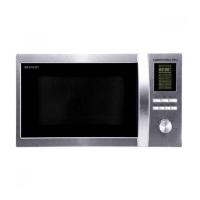Why is my Sharp R-954AST Microwave Oven cooking too slowly?
- NnguyenkaylaAug 4, 2025
If your Sharp Microwave Oven is cooking too slowly, make sure that you have selected the correct power level.

Why is my Sharp R-954AST Microwave Oven cooking too slowly?
If your Sharp Microwave Oven is cooking too slowly, make sure that you have selected the correct power level.
What to do if my Sharp R-954AST Microwave Oven control panel will not work?
If the display of your Sharp Microwave Oven is lit but the control panel doesn't respond when pressed, the first thing you should check is whether the door is closed properly.
Why is the outer cabinet of my Sharp Microwave Oven hot?
If the outer cabinet of your Sharp Microwave Oven is hot, it is normal for the cabinet to become warm to the touch. Keep children away from the appliance when it is in use.
What to do to prevent arcing potatoes in my Sharp R-954AST?
To prevent potatoes from arcing in your Sharp Microwave Oven, make sure to remove all "eyes" from the potatoes and pierce them before cooking. Place them directly on the turntable or in a heat-resistant flan dish.
Why does condensation form in my Sharp Microwave Oven?
Condensation forms in your Sharp Microwave Oven because the oven cavity is typically colder than the food being cooked. Steam produced during cooking condenses on the colder surfaces. The amount of steam depends on the water content of the food. Condensation trapped in the door glass should clear after a few hours.
Why is there a draught circulating around the door of my Sharp Microwave Oven?
When the Sharp Microwave Oven is working, air circulates within the cavity. The door does not form an airtight seal, so air may escape from the door.
| Brand | Sharp |
|---|---|
| Model | R-954AST |
| Category | Microwave Oven |
| Language | English |
Guidelines for users in private households on how to dispose of the appliance.
Guidelines for business users on how to dispose of the appliance.
Explains the various indicators and display elements on the control panel.
Details the temperature progress indicator and its segments.
Covers general usage, installation, and handling precautions for safe operation.
Details warnings related to fire hazards, personal injury, and electric shock.
Addresses risks of explosions, sudden boiling, burns, and misuse by children.
Provides additional warnings for operation and advice to prevent oven damage.
Details on proper oven placement, required clearances, and ventilation.
Instructions for safely connecting the oven to the power supply.
Step-by-step guide on how to set the 24-hour clock feature.
Instructions for using the kitchen timer for non-cooking timing needs.
Details the 5 power levels and their recommended uses.
Steps for opening the door, starting the oven, and using controls.
Instructions for manual cooking and defrosting using power levels and time.
How to use the grill feature, including using the rack for specific foods.
Instructions for using the grill-only function with examples.
Details the combination cooking modes and provides an example for C-1.
Guide to preheating and cooking using convection temperatures and times.
Instructions for cooking with convection without preheating.
How to defrost and cook using multiple stages.
Using the START button for quick 30-second additions or direct start.
How to activate and deactivate the child lock for safety.
Instructions for defrosting food based on weight.
How to defrost food using a set time duration.
Guide to using pre-programmed auto menus for specific foods.
Detailed steps for preparing and baking a sponge cake using Auto Menu A9.
Important notes and tips for using the microwave popcorn feature.
Instructions for cleaning the oven's outer surfaces and control panel safely.
Guide to cleaning the oven cavity, waveguide cover, and turntable.
Specific instructions for cleaning the oven door, seals, and glass.
Basic troubleshooting steps and crucial warnings before seeking service.
A table listing common queries and their corresponding answers.
